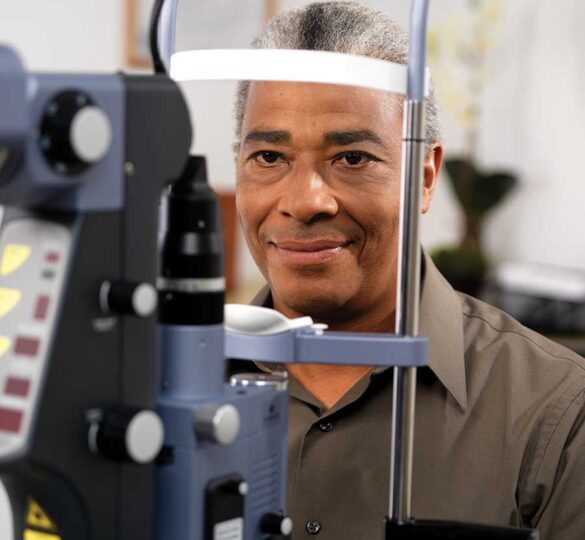Trabeculoplastia láser selectiva: 10 preguntas frecuentes

La trabeculoplastia láser selectiva, o SLT (Selective Laser Trabeculoplasty), es una forma de cirugía con láser que se utiliza para disminuir la presión intraocular en el glaucoma.
Se utiliza cuando las gotas oftálmicas no disminuyen la presión ocular lo suficiente o causan efectos secundarios significativos. También se puede usar como tratamiento inicial en el glaucoma. La SLT se ha usado durante más de 25 años en los Estados Unidos y en todo el mundo.
1. ¿Quiénes son candidatos para la SLT?
Los pacientes que tienen glaucoma primario o secundario de ángulo abierto (el sistema de drenaje en la parte frontal del ojo está abierto) y necesitan disminuir su presión intraocular (PIO) son elegibles para el procedimiento. Su oftalmólogo tomará la decisión final si usted es candidato.
2. ¿Cómo funciona?
Se aplica la energía del láser en el tejido de drenaje en el ojo. Esto inicia un cambio químico y biológico en el tejido que da como resultado un mejor drenaje del líquido a través del drenaje y fuera del ojo. Esto finalmente provoca una disminución de la PIO. Pueden pasar de 1 a 3 meses para que aparezcan los resultados.
3. ¿Por qué se llama selectiva?
El tipo de láser utilizado tiene una absorción de energía térmica mínima, ya que solo se absorbe mediante el tejido pigmentado seleccionado en el ojo. A veces se conoce como “láser frío”. Debido a esto, el procedimiento produce menos tejido cicatricial y tiene un dolor mínimo.
4. ¿Cuáles son los riesgos?
Un aspecto clave de la SLT es un perfil favorable de efectos secundarios, incluso cuando se compara con los medicamentos para el glaucoma. La inflamación postoperatoria es común, pero generalmente leve, y se trata con observación o gotas oftálmicas o un fármaco antiinflamatorio no esteroideo oral. Hay aproximadamente un 5 % de incidencia de elevación de la PIO después del láser, que se puede controlar con los medicamentos para el glaucoma y, por lo general, desaparece después de 24 horas.
5. ¿Qué tan efectivo es y cuánto dura?
La SLT disminuye la PIO en aproximadamente un 30 % cuando se utiliza como terapia inicial. Esto es comparable a la disminución de la PIO con la clase de medicamentos para el glaucoma más potente y de uso más frecuente (análogos de prostaglandina). Este efecto puede reducirse si el paciente ya toma medicamentos para el glaucoma. El efecto generalmente durará entre 1 y 5 años y, en algunos casos, más que eso. Si no dura al menos entre 6 y 12 meses, por lo general no se considera exitoso.
6. ¿Qué sucede si desaparece?
Si la SLT es efectiva para reducir la PIO, pero este efecto desaparece con el transcurso de varios años, el procedimiento puede repetirse. Los tratamientos repetidos pueden o no disminuir la PIO tanto como el primero, y la repetición continua del tratamiento con láser finalmente no será eficaz. Algunos médicos pueden elegir tratar la mitad del tejido en el primer tratamiento, luego tratar la segunda mitad en una fecha posterior (esto no se considera tratamiento repetido, sino que es la finalización del tratamiento). Si la SLT no es exitosa inicialmente, es poco probable que la repetición del tratamiento sea eficaz. Como alternativa, se pueden utilizar los medicamentos para el glaucoma si el efecto desaparece con el tiempo.
7. ¿Qué sucede si no funciona?
Si la SLT no disminuye la PIO, entonces el glaucoma se trata por otros medios, como medicamentos o cirugía. El láser no afecta el éxito de estos otros tipos de tratamiento.
8. ¿Cuál es el costo?
Dado que el procedimiento es un tratamiento aceptado para el glaucoma, y está aprobado por la FDA, está cubierto por Medicare y el seguro médico. El costo para una persona sin seguro o con un copago de seguro variará.
9. ¿Todavía tendré que usar medicamentos para el glaucoma?
Algunos pacientes se pueden controlar solo con tratamiento con láser. Otros requieren una disminución adicional de la PIO y, por lo tanto, es posible que también necesiten medicamentos para el glaucoma. Piense en la SLT como equivalente a un medicamento para el glaucoma. Del mismo modo que algunos pacientes requerirán más de un medicamento para el glaucoma para controlar su PIO, algunos también pueden requerir láser y uno o más medicamentos para el glaucoma. Es importante recordar que la SLT no es una cura para el glaucoma, al igual que los medicamentos y la cirugía tampoco lo son. Cualquiera que sea el método que se utilice para tratar el glaucoma, el seguimiento adecuado y los exámenes con su profesional de la vista son fundamentales.
10. ¿Cuáles son los tratamientos con láser alternativos?
Otros procedimientos similares son la trabeculoplastia con láser de argón (argon laser trabeculoplasty, ALT) y la trabeculoplastia láser con micropulso (micropulse laser trabeculoplasty, MLT). La ALT fue el primer procedimiento de trabeculoplastia con láser. Utiliza un láser térmico (calor) y puede causar más cicatrices en el ángulo de drenaje que la SLT, lo que también puede limitar su capacidad para repetirse. La MLT se diseñó para reducir la cantidad de energía entregada a los tejidos oculares pulsando la energía en pequeños incrementos. Por lo tanto, tiene beneficios potenciales similares a la SLT en términos de menor inflamación, cicatrización del tejido y capacidad de repetirse. Los resultados de disminución de la PIO de la SLT, la ALT y la MLT son similares.
En resumen, la SLT es un tratamiento con láser para el glaucoma de ángulo abierto que disminuye la presión ocular. Se puede utilizar como tratamiento inicial, en lugar de las gotas oftálmicas, o como tratamiento adicional cuando los medicamentos no disminuyen la presión ocular lo suficiente. Suele ser eficaz, pero el efecto puede desaparecer después de un período de tiempo. Puede repetirse, pero el efecto puede reducirse con la repetición del tratamiento. La SLT no es una cura para el glaucoma, sino una de las muchas herramientas para mantenerlo bajo control.
—
Artículo del Dr. Brian A. Francis, profesor de Oftalmología en Doheny Eye Institute, David Geffen School of Medicine, University of California, Los Ángeles.

Brian A. Francis, MD, MS
Brian A. Francis, MD, MS is the Steiger Endowed Professor of Ophthalmology at the Doheny and Stein Eye Institutes, David Geffen School of Medicine, University of California, Los Angeles.